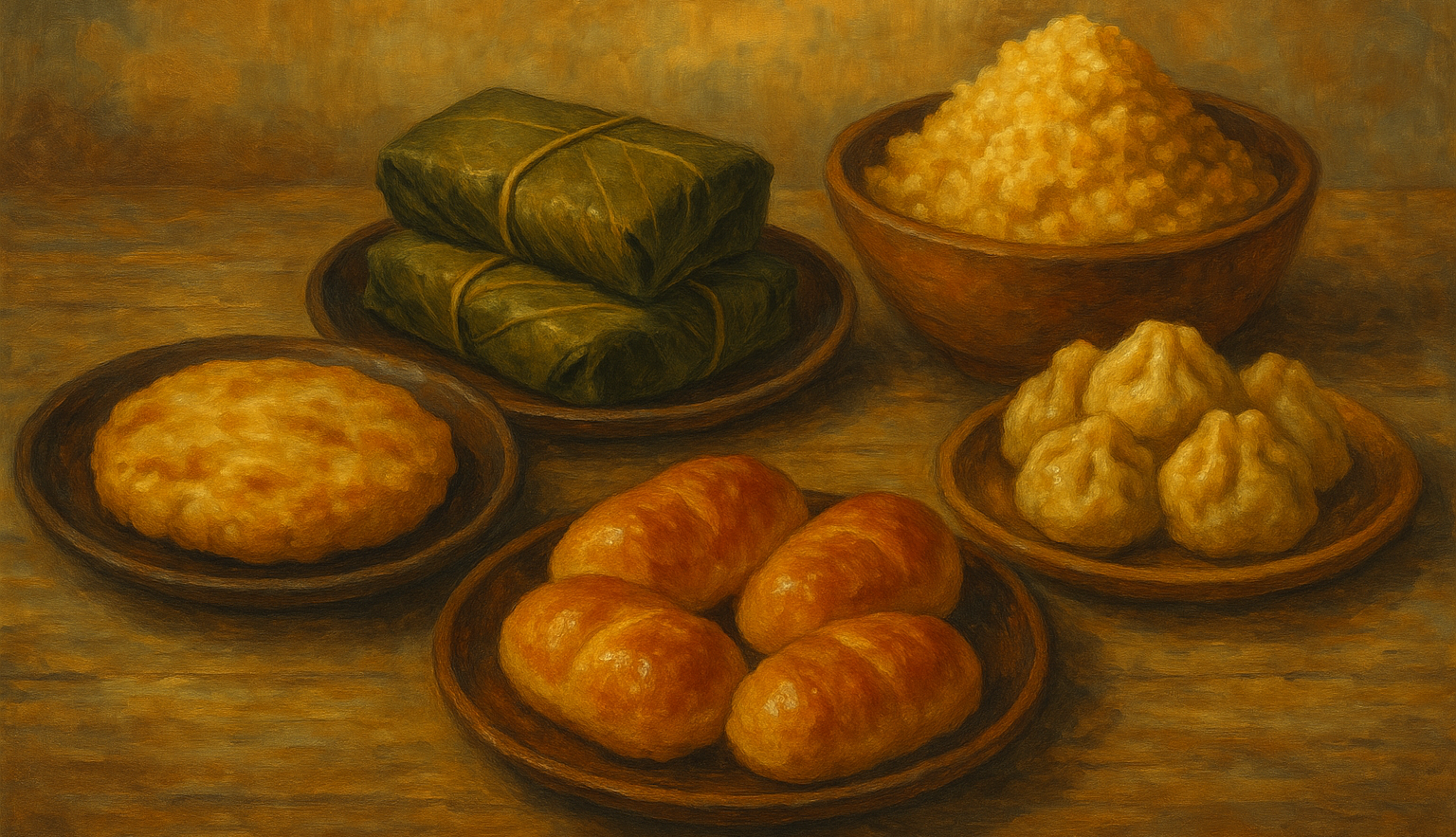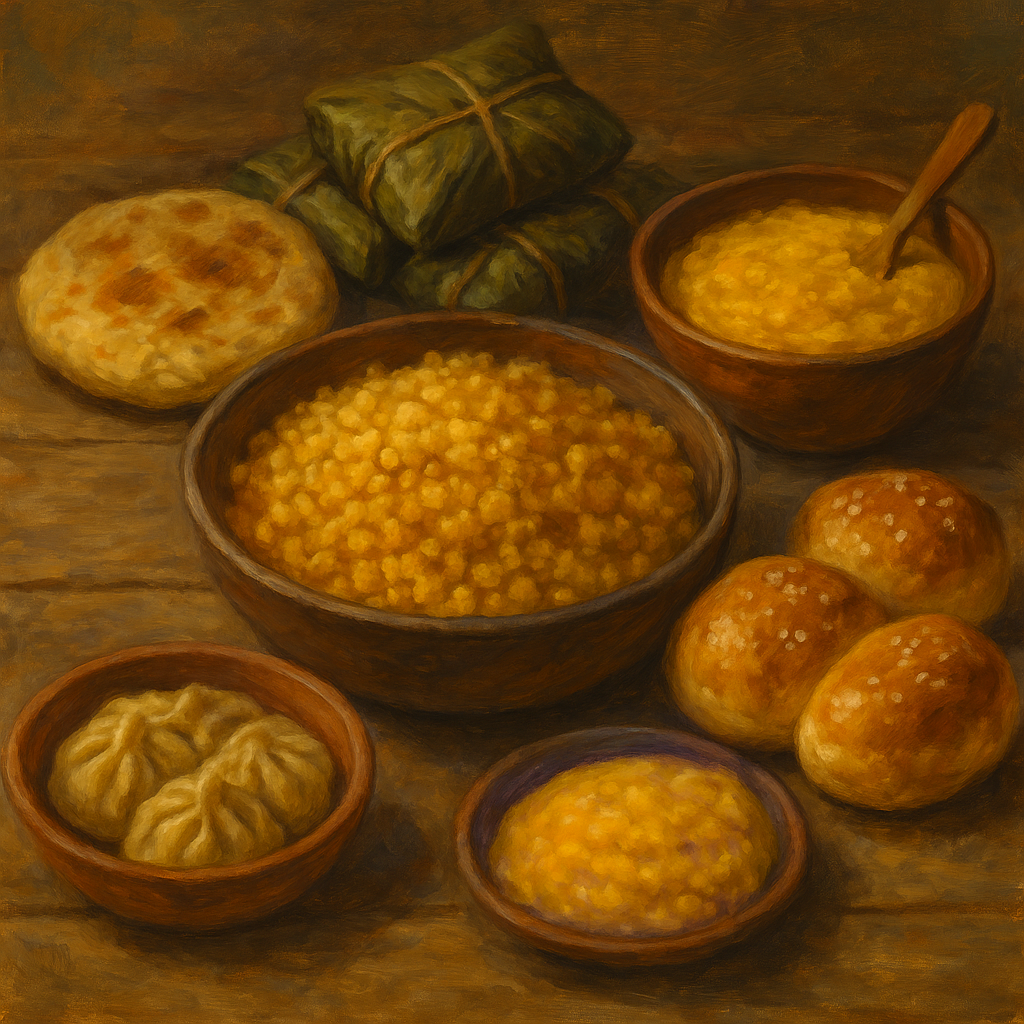Hearthgrain
Hearthgrain is Tanaria’s most widespread and beloved staple—a golden, nutty grain said to have been a gift from Sylvanna herself. Found on dinner tables across every kingdom, it’s versatile, hearty, and deeply rooted in cultural tradition.
While the grain itself is the same, every region has their own cherished way of preparing it: rakka flatbreads in Kalros, jungle-wrapped cakes in Necai, saffron porridge in Dhuma, honey-brushed blessing rolls in Kamulos, and fermented dumplings in Eouma.
More than food, Hearthgrain is a symbol of survival, family, and heritage—warm, grounding, and always shared.
Kalros – Rakka Flatbread
Thick, chewy flatbreads baked on hot stones, often cooked with marrow broth or root veg mash folded into the dough. Portable, hearty, and durable in cold climates. Warriors carry strips of dried rakka for long hunts.Necai – Jungle Cakes
Sticky, steamed cakes wrapped in broad fronds, usually filled with spiced fish paste, mashed fruit, or shredded tuber. Hearthgrain here is sweeter and slightly purple from the soil—eaten with fingers, dipped in chili-paste or nectar sauces.Dhuma – Sungrain Porridge
Toasted hearthgrain cooked down into a bright, saffron-hued porridge. Often mixed with dried dates, crushed nuts, or goat cheese. Served morning and night, always warm. Wealthier households garnish it with cinnamon and gold flake.Kamulos – Blessing Rolls
Soft, airy rolls brushed with honey-butter and sea salt, served hot with nearly every meal. Called “blessing rolls” because they’re broken and shared as part of mealtime grace. Bakers compete yearly for the fluffiest batch.Eouma – Stone Dumplings
Fermented dough dumplings made with wild herbs, mushrooms, and bitter greens. Steamed over spring water or baked in shared village ovens. Each household has a secret mix of spice and filler passed down through generations.Isles of Makaroa – Ember-Pan Hearthcakes
Fried over open flame in shallow pans, these small hearthcakes are chewy inside, crisp outside, and often topped with sweet jam, grilled meats, or pickled citrus. A sacred offering during sea-blessing rituals.History
Hearthgrain’s origins trace back to the early Harmonium Era, when the scars of the Calamity still marred the land. Legend says that in those bleak years of hunger and instability, Sylvanna, the Verdant Mother, wept for the suffering of mortals. From her tears sprang the first stalks of Hearthgrain, resilient, golden, and warm to the touch. It grew even in ash-choked soil and barren hills, symbolizing hope and rebirth.
Hearthgrain is believed to have first sprouted in the Riverlands of Kamulos during the early rebuilding years after the Calamity Era. According to both agricultural records and religious texts, the grain emerged after a rare celestial alignment of Callista and Umbriel—an event many interpreted as a divine omen.
The earliest written mention of Hearthgrain appears in a carved stone tablet from the farming village of Laren’s Hollow, where it’s called “the Mother’s Mercy.” From there, its cultivation spread like wildfire, aided by druidic circles, migrating clans, and relief caravans backed by the first coalitions of post-Cataclysm aid.
Though its divine origin is debated by scholars, no one denies that Hearthgrain’s appearance marked a turning point in Tanaria’s survival.
Early farming tribes quickly learned its value. Unlike other crops, Hearthgrain required minimal tending and seemed to respond positively to song, prayer, and the presence of family gatherings. It spread quickly, first through barter, then through conquest, migration, and trade. By the time kingdoms began to solidify, Hearthgrain had already become a cultural cornerstone across Tanaria.
In Kalros, it was first dried and ground into dense survival cakes for long treks across icy mountains. In Necai, jungle clans cultivated heartier strains that thrived on humidity and fermented in their husks. During the early wars between Kamulos and Dhuma, entire ceasefires were brokered to allow Hearthgrain harvests to pass untouched, a rare mark of mutual respect.
Today, Hearthgrain remains a deeply symbolic crop. It features in seasonal festivals, funerals, weddings, and coming-of-age rituals. Many still believe that planting it in circles wards off famine or invites familial harmony. While newer crops have risen in status among the elite, no food is as unifying, enduring, or soul-deep as Hearthgrain.
Item type
Consumable, Food / Drink
Creation Date
7 HE
Rarity
Common. Extremely widespread.
Hearthgrain is one of the most cultivated crops in Tanaria. Its magically adaptable nature allows it to grow in nearly any climate—arctic tundra, jungle terraces, volcanic slopes, and coastal farmlands alike. While the preparations may vary wildly by region, the grain itself is everywhere. Even the poorest villages keep a stockpile, and it's so ingrained in daily life that a meal without it is often considered incomplete.
Hearthgrain is one of the most cultivated crops in Tanaria. Its magically adaptable nature allows it to grow in nearly any climate—arctic tundra, jungle terraces, volcanic slopes, and coastal farmlands alike. While the preparations may vary wildly by region, the grain itself is everywhere. Even the poorest villages keep a stockpile, and it's so ingrained in daily life that a meal without it is often considered incomplete.





Comments